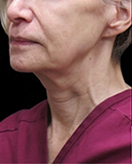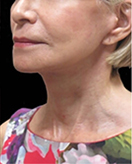Facial Fat Transfer
Conveniently located to serve the areas of New York, NY

Facial fat transfer can accentuate facelift results by providing volume to wrinkles and creases around the upper, mid, and lower face. As you age, your skin begins to lose the youthful structure of its past. Lax skin tends to hang, resulting in unsightly drooping around the eyes and midface. In addition, facial volume begins to diminish, leading to facial folds and cheek hollows. Combining a facelift with fat transfer can elevate sagging facial tissues while providing volume to gaunt areas. Facelift surgery targets loose skin around the brows, eyes, temples, cheeks, lips, and chin to provide a lifting effect to rejuvenate these areas, while facial fat grafting uses your body’s own fat to enhance definition by collecting fat cells from the body through liposuction. This natural fat is then carefully injected into facial areas to fill in wrinkles and fine lines for younger-looking facial rejuvenation results.
Contents
- 1 Benefits
- 2 Procedure Details
- 3 FAQ
- 3.1 How Do Facial Fat Transfer And Facelift Work?
- 3.2 Can Facial Fat Transfer And Facelift Be Used Alongside Other Procedures?
- 3.3 Am I An Ideal Candidate For Facial Fat Transfer And Facelift Treatment?
- 3.4 What Type Of Anesthesia Is Involved During My Facial Fat Transfer And Facelift Procedure?
- 3.5 What Can I Expect After Undergoing Facial Fat Transfer And Facelift In NYC?
- 3.6 What Kind Of Facial Fat Transfer And Facelift Results Can I Expect?
- 3.7 How Can I Maximize My Facial Fat Transfer And Facelift Results?
Benefits
Facial Fat Transfer
- Can volumize facial wrinkles & hollows for long-lasting results
- Simultaneously slims down the donor site while adding definition to your facial profile
- Accentuates facial contours for youthful-looking features
- Can reduce the appearance of skin irregularities for smooth definition
Facelift
- Tightens sagging skin to provide a lifting effect
- Can correct unsightly jowls around the cheeks
- Addresses neck laxity
- Improves the appearance of facial creases & fine lines
- Can achieve long-lasting facial definition for a younger-looking appearance
Procedure Details
- Performed in our AAAASF-accredited NYC surgical suite
- Procedure time ranges from 3-5 hours
- Local, general, or twilight anesthesia is used, depending on the extent of your procedure
- Patients are free to return home the same day as treatment
FAQ
How Do Facial Fat Transfer And Facelift Work?
Facial fat transfer uses a combination of liposuction techniques and fat injections to achieve facial surgery results. Facial fat grafting is a two-part procedure in which your body’s natural fat is transferred from the donor site to the targeted area(s) of the face. Common donor areas include the abdomen, flanks, or thighs, where there are ample fat cells to collect. Once the donor site is prepared, small incisions are made and tiny cannulas are placed underneath the skin. These cannulas gently extract the desired amount of fat from the body. Fat cells are carefully cultivated to ensure a high survival rate. After collection, your natural fat is injected into the target area(s) around the face to provide natural-looking volume to your facial profile.
Facelift surgery is comprised of two components that can achieve long-lasting results for patients. During a facelift, facial tissues underneath the skin are repositioned, tightened, or elevated to restore a youthful balance to the facial foundation. Excess skin is then removed or repositioned to further promote natural, long-lasting results. Our NYC plastic surgeon utilizes a variety of different surgical techniques when performing a facelift. Dr. Levine will discuss which facelift techniques are ideal for your facial rejuvenation procedure during your consultation at our New York City office.
Can Facial Fat Transfer And Facelift Be Used Alongside Other Procedures?
Yes. Facial fat transfer and facelift surgery can be used in conjunction with other facial rejuvenation or liposuction procedures to achieve optimal results, including neck lift surgery, submental liposuction, blepharoplasty, browlift, chin augmentation, SmartLipo®, and VASER® LipoSelection. Dr. Levine will discuss which procedures may best enhance your facial rejuvenation results.
Am I An Ideal Candidate For Facial Fat Transfer And Facelift Treatment?
Facial fat transfer and facelift surgery can benefit patients looking to reduce the appearance of sagging facial skin, wrinkles, and fine lines. Facial fat transfer can provide youthful volume to the face, while undergoing a facelift can reposition skin for a rejuvenated appearance. Patients looking for a solution to facial aging can opt for facial fat grafting with facelift surgery for long-term results. Dr. Levine will discuss if facial fat transfer and facelift is right for you during your consultation at our New York City office.
What Type Of Anesthesia Is Involved During My Facial Fat Transfer And Facelift Procedure?
Facial fat transfer and facelift surgery may require either local, general, or twilight anesthesia, depending on your specific facial rejuvenation procedure. Dr. Levine will discuss which form of anesthesia is ideal for your facial fat transfer and facelift surgery during your consultation at our New York City office.
What Can I Expect After Undergoing Facial Fat Transfer And Facelift In NYC?
Mild bruising and swelling around the donor and treatment sites are common in the weeks following facial fat transfer and facelift surgery. These side effects should subside within a few weeks of your procedure. Patients often return to work within one to two weeks of their facial rejuvenation procedure, though additional recovery time may be necessary for physical activity, including exercise. The exact amount of healing time required after undergoing facial fat transfer and facelift surgery varies from patient to patient and is dependent on the specifics of each procedure.
What Kind Of Facial Fat Transfer And Facelift Results Can I Expect?
Facial fat transfer and facelift can achieve long-lasting, natural-looking results for patients. Facelift surgery can enhance facial contours and provide a lifting effect to restore your features to a youthful-looking position. Facial fat transfer can slim down the donor site by removing fat cells from the body. Additionally, facial fat grafting can add long-lasting volume to facial hollows or wrinkles.
How Can I Maximize My Facial Fat Transfer And Facelift Results?
In order to maximize your facial fat transfer and facelift results, it is important to follow all pre and post-operative instructions provided by Dr. Levine.
Pre-Care
Certain products and supplements should be avoided in the weeks prior to your facial fat transfer and facelift procedure, unless medically necessary. By doing so, patients minimize their risk of bruising and swelling. Blood-thinners and medications that contain ibuprofen or aspirin should be avoided. Patients should also refrain from taking multivitamins and herbal supplements.
Post-Procedure
Certain medications, including Tylenol, Bromelain, and Arnica Montana, may be recommended to alleviate pain or discomfort post-procedure. For more details regarding our facial fat transfer and facelift aftercare suggestions, click here.
Dr. Elie Levine, Dr. Jody Levine, and the NYC Lipo staff will be happy to meet with you to discuss your liposuction needs.Please call our office at (800) 683-5476, or make an appointment online for a personal consultation in our New York City offices.


